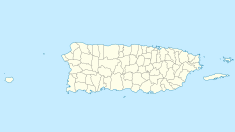El Morro Castle
| Castillo San Felipe del Morro | |
|---|---|

Bird's-eye view of
Castillo San Felipe del Morro |
|
| Location | San Juan, Puerto Rico |
| Coordinates | 18°28′16″N 66°07′27″W / 18.4711°N 66.1242°WCoordinates: 18°28′16″N 66°07′27″W / 18.4711°N 66.1242°W |
| Built | 16th Century |
| Governing body | National Park Service |
| Type | Cultural |
| Criteria | vi |
| Designated | 1983 (7th session) |
| Part of | La Fortaleza and San Juan National Historic Site |
| Reference no. | 266 |
| State Party | United States |
| Region | North America and West Indies |
| Designated | October 15, 1966 |
| Part of | San Juan National Historic Site |
| Reference no. | 66000930 |
Castillo San Felipe del Morro also known as Fuerte San Felipe del Morro or Castillo del Morro, is a 16th-century citadel located in San Juan, Puerto Rico.
Lying on the northwestern-most point of the islet of Old San Juan, Castillo San Felipe del Morro is named in honor of King Philip II of Spain. The fortification, also referred to as el Morro or 'the promontory,' was designed to guard the entrance to the San Juan Bay, and defend the Spanish colonial port city of San Juan from seaborne enemies.
In 1983, the citadel was declared a World Heritage Site by the United Nations in conjunction with the San Juan National Historic Site. Over two million visitors a year explore the castillo, making it one of Puerto Rico's leading tourist attractions. Facing the structure, on the opposite side of the bay, a smaller fortification known as El Cañuelo complemented the castillo's defense of the entrance to the bay.
The construction of the citadel and its surrounding walls began in 1539 on orders of King Charles V of Spain. Its main purpose was to defend the port of San Juan by controlling the entry to its harbor. In order to have a viable defense while the rest of the fort was being completed, a small proto-fortress was erected during the first year of construction. It is estimated that this section comprises about 10% of the whole structure. It was not till 1587, however, that engineers Juan de Tejada and Juan Bautista Antonelli drew the fort's final design, which was based on the then firmly established Spanish military fortification principles of the time. Thus, similar Spanish fortifications of the 17th to 18th centuries can be found in Cuba, Santo Domingo, the Dominican Republic, Puerto Rico, Veracruz and Acapulco, Mexico, Portobelo, ″Cartagena″ de Indias and Panama City, Panamá, Guatemala, Honduras, and many other Latin American locations which were part of the Spanish Empire during the Age of Exploration.
...
Wikipedia

